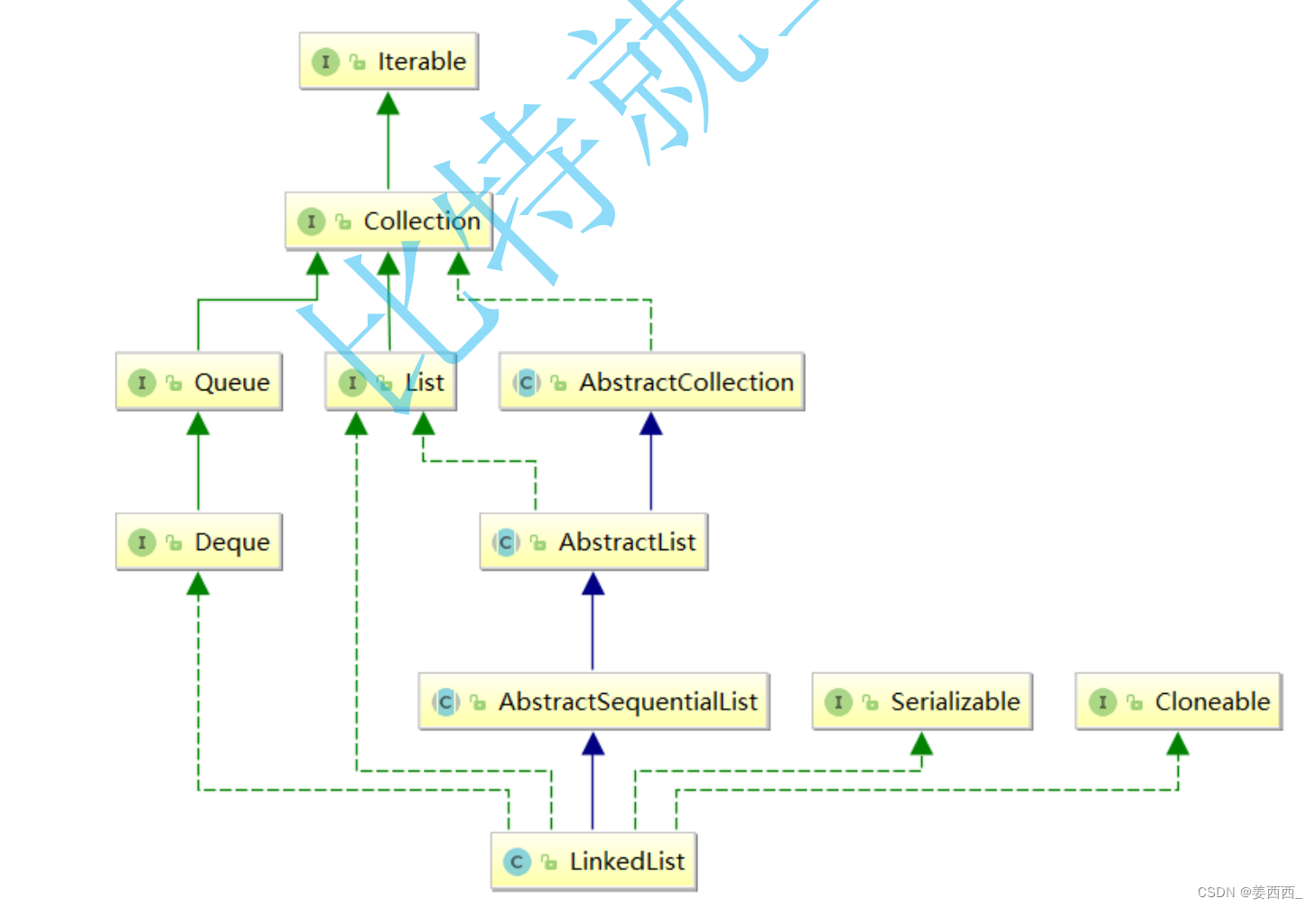LinkedList
一. LinkedList简介
LinkedList和ArrayList一样, 在集合框架中, LInkedList也是一个类, 实现了List接口:

但是与我们上次定义的MySingleList不同, 上次的定义的无头单向非循环链表, 而LinkedLIst是无头双向非循环链表, 画图理解一下:

二.?LinkedList的简单实现
无头双向非循环链表的实现:
?IList.java:
public interface IList {
//头插法
void addFirst(int data);
//尾插法
void addLast(int data);
//任意位置插入,第一个数据节点为0号下标
void addIndex(int index,int data);
//查找是否包含关键字key是否在单链表当中
boolean contains(int key);
//删除第一次出现关键字为key的节点
void remove(int key);
//删除所有值为key的节点
void removeAllKey(int key);
//得到单链表的长度
int size();
void clear() ;
void display() ;
}IndexException.java:
public class IndexException extends RuntimeException{
public IndexException() {
}
public IndexException(String message) {
super(message);
}
}?KeyException.java:
public class KeyException extends RuntimeException{
public KeyException() {
}
public KeyException(String message) {
super(message);
}
}MyLinkedList.java:
/**
* Created with IntelliJ IDEA.
* Description:
* User: Jiang Jinxi
* Date: 2023-12-27
* Time: 13:42
*/
public class MyLinkedList implements IList {
static class ListNode{
public ListNode prev;
public int val;
public ListNode next;
public ListNode(int val) {
this.val = val;
}
}
public ListNode head;
public ListNode last;
@Override
public void addFirst(int data) {
ListNode node = new ListNode(data);
if(head == null){
head = node;
last = node;
}else{
node.next = head;
head.prev = node;
head = node;
}
}
@Override
public void addLast(int data) {
ListNode node = new ListNode(data);
if(head == null){
head = node;
last = node;
}else{
last.next = node;
node.prev = last;
last = node;
}
}
@Override
public void addIndex(int index, int data) {
if(index < 0 || index > size()){
throw new IndexException("index 不合法" + index);
}
if(index == 0){
addFirst(data);
return;
}
if(index == size()){
addLast(data);
return;
}
ListNode cur = head;
while(index != 0){
cur = cur.next;
index--;
}
//插入结点
ListNode node = new ListNode(data);
node.next = cur;
cur.prev.next = node;
node.prev = cur.prev;
cur.prev = node;
}
@Override
public boolean contains(int key) {
ListNode cur = head;
while(cur!=null) {
if (cur.val == key) {
return true;
}
cur = cur.next;
}
return false;
}
@Override
public void remove(int key) {
if(!contains(key)){
throw new KeyException("找不到key" + key);
}
//如果只有一个结点且该节点的值就是我要删的数字
if(head.next == null && head.val == key){
head = null;
last = null;
return;
}
//循环遍历结点
ListNode cur = head;
while(cur!=null) {
if (cur.val == key) {
//如果要删除的是头结点
if(cur == head){
head = head.next;
head.prev = null;
return;
}
//如果要删除的是尾结点
if(cur == last){
last = last.prev;
last.next = null;
return;
}
//是中间结点
cur.prev.next = cur.next;
cur.next.prev = cur.prev;
return;
}
cur = cur.next;
}
}
@Override
public void removeAllKey(int key) {
if(!contains(key)){
throw new KeyException("找不到key" + key);
}
ListNode cur = head;
if(cur.next == null && cur.val == key){
head = null;
last = null;
return;
}
while(cur!=null) {
if (cur.val == key) {
if(cur == head){
head = head.next;
head.prev = null;
}
if(cur == last) {
last = last.prev;
last.next = null;
}
cur.prev.next = cur.next;
cur.next.prev = cur.prev;
}
cur = cur.next;
}
}
@Override
public int size() {
ListNode cur = head;
int count = 0;
while(cur != null){
cur = cur.next;
count++;
}
return count;
}
@Override
public void clear() {
head = null;
last = null;
}
@Override
public void display(){
ListNode cur = head;
while(cur != null) {
System.out.println(cur.val + " ");
cur = cur.next;//遍历所有节点
}
}
}
三. LinkedList的使用
1. LinkList的构造
1)无参构造

// 构造一个空的 LinkedListList < Integer > list1 = new LinkedList <> ();
2)使用其他集合容器中元素构造List ?

List < String > list2 = new ArrayList <> ();list2 . add ( "JavaSE" );list2 . add ( "JavaWeb" );list2 . add ( "JavaEE" );// 使用 ArrayList 构造 LinkedListList < String > list3 = new LinkedList <> ( list2 );
2. LinkedList的其他常用方法介绍?

方法与ArrayList类似, 不再赘述
3. LinkedList的遍历
第一种:for循环
// 使用下标+for遍历
for (int i = 0; i < linkedList.size(); i++) {
????????System.out.print(linkedList.get(i) + " ");
}
?第二种: for-each
// 借助foreach遍历
for (Integer x?: linkedList) {
????????System.out.print(x?+ " ");
}
System.out.println();
第三种: 使用迭代器
可以使用迭代器的原因是: 继承了Iterable接口
从前往后:?
Iterator<Integer> it = linkedList.iterator();
while(it.hasNext()){
????????System.out.print(it.next() + " ");
}
或
ListIterator<Integer> it = linkedList.listIterator();
while(it.hasNext()){
????????System.out.print(it.next() + " ");
}
注: ListIterator是Iterator的子类
?从后往前:
ListIterator<Integer> it = linkedList.listIterator(linkedList.size() );
while(it.hasPrevious()){
????????System.out.print(it.previous() + " ");
}
四. ArrayList和LinkedList的区别

本文来自互联网用户投稿,该文观点仅代表作者本人,不代表本站立场。本站仅提供信息存储空间服务,不拥有所有权,不承担相关法律责任。 如若内容造成侵权/违法违规/事实不符,请联系我的编程经验分享网邮箱:chenni525@qq.com进行投诉反馈,一经查实,立即删除!
- Python教程
- 深入理解 MySQL 中的 HAVING 关键字和聚合函数
- Qt之QChar编码(1)
- MyBatis入门基础篇
- 用Python脚本实现FFmpeg批量转换
- 加密算法(100%用例)C卷 (Java&&Python&&C++&&Node.js&&C语言)
- 【unity知识点】Unity 协程Coroutine
- RocketMQ
- 「HDLBits题解」Arithmetic Circuits
- 【华为OD机试真题2023C&D卷 JAVA&JS】多段线数据压缩
- 保证Python3.8-3.11能用的dlib轮子
- Java学习(二十一)--JDBC/数据库连接池
- 44、BatchNorm 为什么可以和卷积融合?
- (Matlab)基于CNN-LSTM的多维时序回归预测(卷积神经网络-长短期记忆网络)
- 迅为龙芯2K1000开发板接口全国产处理器尺寸190mm*125mm